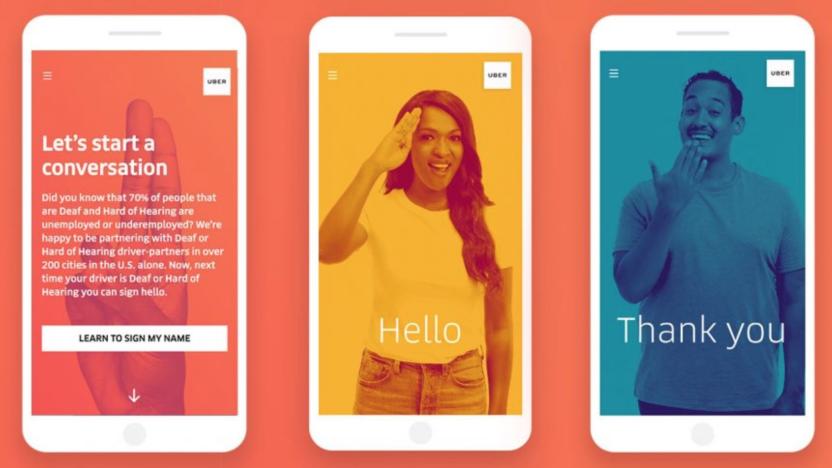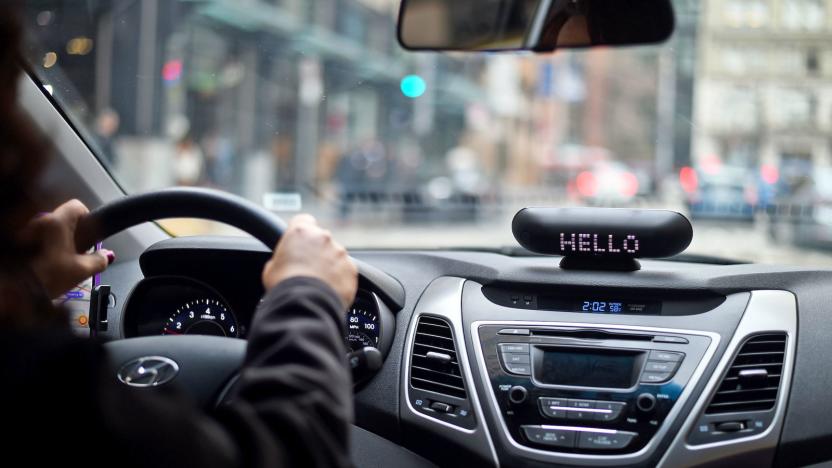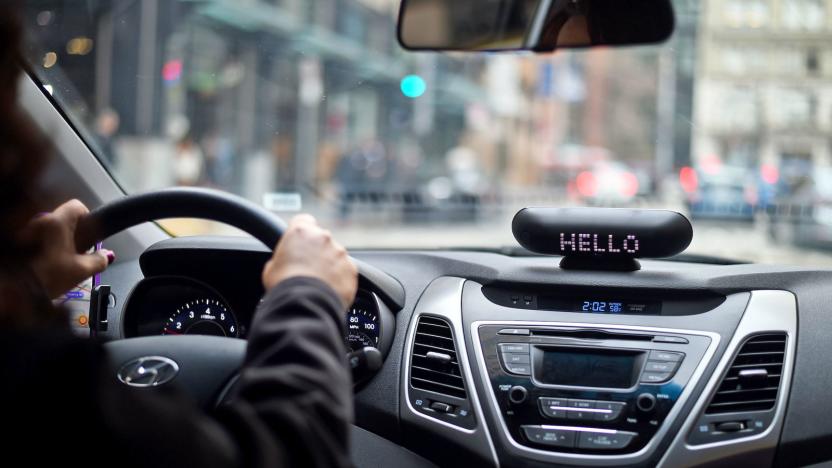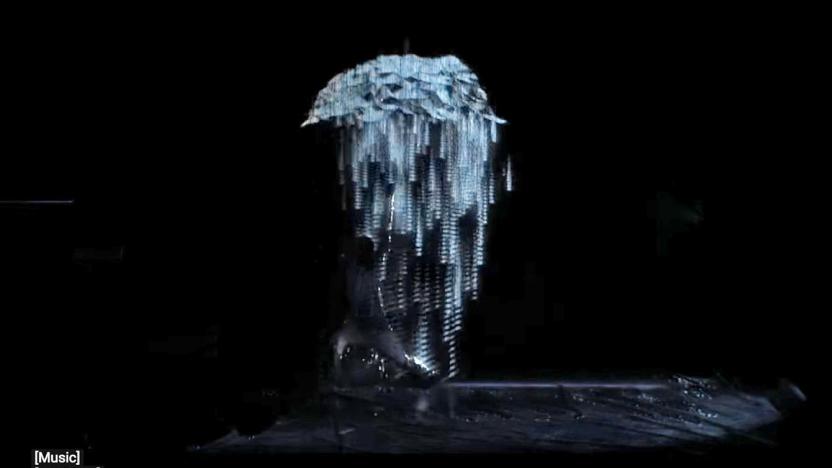hardofhearing
Latest

Uber offers basic sign language tips so you can talk to deaf drivers
Back in 2015, Uber added some features for drivers who were deaf and hard of hearing, including visual notifications of impending rides. Today, as a wrap-up for National Deaf Awareness Month, Uber has updated its main app to teach riders how to sign basic phrases like "hello" and "thank you" for drivers with hearing impairments.

Lyft requests will light up phones for deaf drivers
Back in April, Lyft launched features that made its system easier to use by deaf drivers and those who are hard of hearing. Now, it's adding a couple more to celebrate National Deaf Awareness Month. Thanks to its partnership with the National Association of the Deaf, the ride-hailing firm has developed "flash-on request" for drivers. If they've activated the app's hard-of-hearing accessibility function, they'll get a powerful visual notification whenever a ride request comes in: their phone's screen and flashlight will both light up. When combined with the Amp emblem flashing the words "New Ride," it could lower the chances of a driver missing out on a request.

Lyft's dashboard display helps drivers with hearing impairments
Accessibility isn't just for those with a disability; inclusion benefits all of us. Adding a visual notification to an auditory one hurts nobody, and it allows people with a hearing impairment to participate in normal activities -- like driving for a ride-sharing company. Luckily, Lyft has just added two little tweaks to its system to empower drivers with a hearing impairment.

YouTube automates sound effect captions with AI
YouTube has used algorithms to automatically caption speech for eight years now in an effort to make its billions of videos more accessible for the deaf and hard of hearing. While the feature was pretty rough at first, it has significantly improved it over time, getting "closer and closer to human transcription error rates," Google said in its developers blog. Since speech is just one part of the audio picture, though, YouTube has launched automatic sound effect captioning for the first time.

Sprint to pay $1.2 million over six-month 911 outage
The FCC has slapped Sprint with a $1.2 million fine after it discovered that the network failed to properly handle 911 calls from people with hearing difficulties. The company was found to be neglecting the Captioned Telephone Service, which effectively provides closed-captions for emergency calls. Unfortunately, Sprint, along with the firms that provide the technology, let the system fall over for nearly six months. Anyone trying to make a 911 call between March and September in 2014 using the offering would have been blocked from getting through. Even worse, however, is that Sprint still collected its FCC subsidy that's handed out to maintain the service and prevent it from being a financial burden on the carriers.

Netflix Watch Instantly's life after Starz includes Academy Award winners, more captions
In a change of conversation that would make Don Draper proud, Netflix has picked up its blogging pen and accentuated the positive, even as hundreds of titles provided by Starz Play blinked away this week. The first bit of good news? Content that's coming instead of going includes several movies that scored trophies at last weekend's Academy Awards,including Best Picture winner The Artist, and Best Documentary winner Undefeated that will arrive "later this year, plus Best Animated Feature Rango that goes live on the service March 31st. That extends to movies in theaters too, as last weekend's top two, Act of Valor and Good Deeds, are pay-TV window exclusives for Netflix. The other positive note is that it achieved a goal of offering closed captioning on 80 percent of the hours streamed by the end of last year, and notes 90 percent of streaming is now done on devices that have been updated to support optional captions. The bad news there is that some embedded TV and Blu-ray player software might not be able to be updated for captions, and progress on adding captions for that last twenty percent of content may be slower since it's content that isn't viewed as often. So, is the red envelope company doing enough to keep you hanging around, or are you going to blow through the last few eps of Lillyhammer and pull the eject button?

Netflix's day: Sony movies pulled, new bandwidth options, no more DVD API access and a lawsuit
In an apparent ode to Rebecca Black, Ice Cube and any number of body switch movies, Netflix has had an incredibly active Friday, so sit back while we get you up to speed. Sony Pictures movies from Starz Play are no longer available (on any device, not just the Xbox 360 this time) due to a "temporary contract issue" according to the official blog. According to NewTeeVee, the problem is an "IP distribution cap" that was reached due to Netflix's explosive growth, but with no word on when the movies will be back, you'll be missing The Other Guys. Up next was the National Association of the Deaf, which has filed a lawsuit in Springfield, MA against Netflix, claiming that its failure to provide closed captions on all streaming content puts it in violation of the Americans with Disabilities Act. Netflix last claimed 30 percent of titles were subbed with plans to reach 80 percent by the end of the year, but the press release (and captioned YouTube video) make the case that as a leader in streaming video, it should do better. Netflix also quietly gave US subscribers access to the same bandwidth management options provided to Canadians a few months ago. The new Manage Video Quality settings (shown above) can be found in the Your Account section, and if you're trying to stay under bandwidth caps or just keep seeing buffering, they should help you out at the cost of a few pixels. As if that wasn't enough, the Netflix Tech Blog squeezed in news that it was ending access to "DVD-related features" for apps using its Open API later this year. The move is apparently preparation for expanded international streaming, so if you're trying to manage discs through a third party things may change soon.

NHK's automated, animated sign language translator adds gestures to subtitles (video)
We've seen quite a few devices designed to help hearing impaired users communicate via phone or computer, but Japan's NHK Science & Technology Research Laboratories has just announced a new animated translation system to help get important news to deaf viewers . While televised subtitles may work for those who understand the language, people who were born deaf and learned sign language from an early age can have significantly more difficulty. NHK's system, unveiled at Technology Open House 2011, bypasses this problem by automatically comparing Japanese text to sign language, converting equivalent words into animated onscreen gestures, and replacing differing words with appropriate synonyms. There are, however, a few kinks to work out. While comprehensible, the translations aren't exactly fluent and researchers have been forced to manually adjust some awkward transitions between words. The ultimate goal is to create a system that could be used during emergencies or natural disasters, allowing deaf citizens to receive urgent broadcasts as instantly as their hearing compatriots. You can see it in action, after the break.

Telecommunications device for the deaf gets hitched to a rotary phone, hacked to run Zork
In today's episode of "But will it run Zork?" a chap named Ulysses got the vintage game to run on a TDD (telecommunications device for the deaf) -- a project he built to show off at the Bay Area Maker Faire last weekend. In a move we truly respect, he hunted down a rotary phone lifted straight out of the era when Zork was conceived (that would be the late '70s / early '80s). Then, he modified a modem so that the acoustically coupled TDD could be interfaced -- transmitting at a slow 45.5 baud to make it easy for even ponderous readers to keep up, one line at a time on the TDD's narrow display. Once this was sorted, things weren't exactly smooth sailing when Ulysses started fitting the compressed Zork story file into the system. At first, he tried using an Arduino Pro and an Arduino Mega, but found that neither had enough memory to accommodate the compressed Zork story file. Ultimately, he took a different tack and settled on an embeddable FitPC. We'd love nothing more than to see this thing in action, but in lieu of a video we highly suggest carving out a few minutes and perusing Ulysses' photo blog at the source link.

ZVRS to support live sign language translation via iPhone 4's FaceTime for calls between deaf and hearing users
While SMS and mobile email are great, they still can't match the emotion, interaction, and intonation of a live conversation with someone -- that's why our phones still ship with microphones and speakers, apparently. Of course, this is much more difficult when one of the parties is deaf or hard of hearing, which is where video relay services come in. With the help of a videophone or your computer's webcam, you can make a call with a live translator, who speaks your signed ramblings out loud to the hearing person on the other end. Of course you're usually stuck at a desk when doing this, but now ZVRS is going to be supporting calls made from the iPhone 4 over FaceTime. It might not be quite as sexy as Apple's goosebump-raising iPhone 4 commercial, since the phone obviously makes two-way sign language calls possible, but if the person on the other end doesn't have an iPhone 4 or doesn't know sign language, ZVRS seems like the next best thing. The new service will launch on July 26th. Check out a video of it in action after the break, the actual call starts at 2:25.

New Sprint service transcribes conversation to web in real time
Sprint is rolling out WebCapTel, an extension of its existing CapTel service that shows hard-of-hearing callers what the person on the other end is saying in real time -- but this time around, special equipment isn't needed. As its name implies, WebCapTel works through any web browser using any phone, turning the call into text quickly enough so that callers are able to respond naturally and with their own voice. Pretty darned cool; in fact, we think we're going to give it a try ourselves to see how it does. It's available now for calls within the US, and even better, it's free.

Deaf gamer seeks subtitles support
Kotaku has reprinted an interesting letter from a deaf gamer asking the ESA to support subtitling in video games. The lack of subtitling means a game's story is often incomprehensible to roughly one percent of the population. Not only that, but audio-only cues are sometimes important to the gameplay itself, such as the beeping bomb-detection device in Metal Gear Solid 2.What's worse, deaf and hard of hearing gamers often have no idea whether a game will cater to them going into a purchase. Game packaging rarely notes the availability of subtitles, and game reviews rarely mention audio accessibility (GameCritics is a notable exception, including a deaf and hard of hearing section in its consumer guides).Game accessibility doesn't stop at hearing loss. Developers are working on audio-only games for the blind and The Switch Project supports simple, one-button games that "can be played by anyone, no matter the disability."







